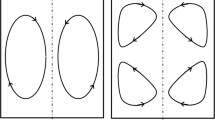Abstract
Critical Rayleigh numbers have been measured in a liquid metal cylinder of finite height in the presence of a rotating magnetic field. Several different stability regimes were observed, which were determined by the values of the Rayleigh and Hartmann numbers. For weak rotating magnetic fields and small Rayleigh numbers, the experimental observations can be explained by the existence of a single non-axisymmetric meridional roll rotating around the cylinder, driven by the azimuthal component of the magnetic field. The measured dependence of rotational velocity on magnetic field strength is consistent with the existence of laminar flow in this regime.
Similar content being viewed by others
Abbreviations
- B 0 :
-
magnitude of magnetic induction
- Br, Bθ :
-
radial and azimuthal magnetic induction components
- C :
-
wall admittance
- d :
-
cell diameter
- d w :
-
wall thickness
- g :
-
gravity at earth's surface
- Ha :
-
Hartmann number
- h :
-
cell height
- k f :
-
thermal conductivity of fluid
- k w :
-
thermal conductivity of wall
- L1, L2, L3, L4:
-
thermistor temperatures
- Ra :
-
Rayleigh number
- Ra c :
-
critical Rayleigh number for the transition from no flow to laminar flow
- Ra t :
-
critical Rayleigh number for the transition from time-independent to time-dependent flow
- r :
-
radial coordinate
- T a :
-
temperature at top of cell
- T b :
-
temperature at bottom of cell
- Δ T:
-
temperature difference between cell bottom and cell top
- ΔTc :
-
critical temperature difference between cell bottom and top time
- t :
-
time
- U1, U2, U3, U4:
-
thermistor temperatures
- z :
-
vertical coordinate
- α:
-
volumetric thermal expansion coefficient
- δ:
-
skin depth
- k :
-
thermal diffusivity
- μ:
-
magnetic permeability
- ν:
-
kinematic viscosity
- ρ:
-
density
- σ:
-
electrical conductivity
- θ:
-
azimuthal coordinate
- ω:
-
angular frequency of magnetic induction
References
Barmin IV; BarminEgorov AV; Barmin-Filatov IG; BarminSenchenkov AS; BarminBenz KW; Lexow B; Salk M; Hofmann P; Sickinger P; Gelfgat JM; Sorkin MZ; Matioukhin DG (1992) CdTe crystal growth by THM with a rotating magnetic field. Proc. of the VIIIth European Symposium on Materials and Fluid Sciences in Microgravity, Brussels, Belgium, 315–320
Bruckner FU; Schwerdtfeger K (1994) Single crystal growth with the Czochralski method involving rotational electromagnetic stirring of the melt. J Cryst Growth 139: 351–356
Buell JC; Catton I (1983) The effect of wall conduction on the stability of a fluid in a right circular cylinder heated from below. J Heat Transfer ASME 105: 255–260
Catton I (1972) Effect of wall conduction on the stability of a fluid in a rectangular region heated from below. J Heat Transfer ASME 94: 446–452
Chandrasekhar RS (1961) Hydromagnetic and Hydrodynamic Stability. Oxford: Clarendon Press
Cusack N; Kendall P (1960) A note on the viscosity and resistivity of liquid gallium. Proc Phys Soc 75: 309–311
Davidson P; Hunt JCR (1987) Swirling recirculating flow in a liquid metal column generated by a rotating magnetic field. J Fluid Mech 185: 67–106
Dold P; Cröll A; Kaiser Th; Salk M; Benz KW (1995) Semiconductor crystals grown under microgravity and in magnetic fields. AIAA paper 95-0264, AIAA 33rd Aerospace Sciences Meeting, Reno, Nevada
Doronin VI; Dremov VV; Kapusta AB (1973) Measurement of the characteristics of the magnetohydrodynamic flow of mercury in a closed cylindrical vessel. Magntinaya Gidrodinamika 3: 138–140
Gelfgat YuM; Gorbunov LA; Kolevzon V (1993) Liquid metal flow in a finite-length cylinder with a rotating magnetic field. Exp Fluids 15: 411–416
Grosse AV (1961) The viscosity of liquid metals and an empirical relationship between their activation energy of viscosity and their melting point. J Inorg N Chem 23: 333–339
Hoather WH (1936) The density and coefficient of expansion of liquid gallium over a wide range of temperature. Proc Phys Soc 48: 699–707
Iida T; Guthrie RIL (1988) The physical properties of liquid metals. Oxford: Clarendon Press
Krishnamurti R (1973) Some further studies on the transition to turbulent convection. J Fluid Mech 60: 285–303
Müller G; Neumann G (1983) Investigation of convective flows in model systems of directional solidification configurations. Proc. of the IVth European Symposium on Materials Sciences under Microgravity, Madrid, Span, 285–294
Müller G; Neumann G; Weber W (1984) Natural convection in vertical bridgman configurations. J Cryst Growth 70: 78–93
Nalgiev AV; Ibragimov KI (1974) Surface tension and density in the tin-gallium system. Russian J Phys Chem 48: 754–756
Neumann G (1986) Dissertation, Universität Erlangen-Nürnberg
Neumann G (1990) Three-dimensional numerical simulation of buoyancy-driven convection in vertical cylinders heated from below. J Fluid Mech 214: 559–578
Powell RL; Childs GE (1972) American Institute of Physics Handbook, p. 4–153, New York: McGraw-Hill
Weber W (1988) Dissertation, Universität Erlangen-Nürnberg
Author information
Authors and Affiliations
Additional information
This work was supported by the Microgravity Science and Applications Division of the National Aeronautics and Space Administration.
Rights and permissions
About this article
Cite this article
Volz, M.P., Mazuruk, K. Flow transitions in a rotating magnetic field. Experiments in Fluids 20, 454–459 (1996). https://doi.org/10.1007/BF00189385
Received:
Accepted:
Issue Date:
DOI: https://doi.org/10.1007/BF00189385




